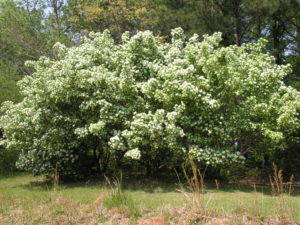The Sweet Smelling Chinese Fringetree
go.ncsu.edu/readext?685155
en Español / em Português
El inglés es el idioma de control de esta página. En la medida en que haya algún conflicto entre la traducción al inglés y la traducción, el inglés prevalece.
Al hacer clic en el enlace de traducción se activa un servicio de traducción gratuito para convertir la página al español. Al igual que con cualquier traducción por Internet, la conversión no es sensible al contexto y puede que no traduzca el texto en su significado original. NC State Extension no garantiza la exactitud del texto traducido. Por favor, tenga en cuenta que algunas aplicaciones y/o servicios pueden no funcionar como se espera cuando se traducen.
Português
Inglês é o idioma de controle desta página. Na medida que haja algum conflito entre o texto original em Inglês e a tradução, o Inglês prevalece.
Ao clicar no link de tradução, um serviço gratuito de tradução será ativado para converter a página para o Português. Como em qualquer tradução pela internet, a conversão não é sensivel ao contexto e pode não ocorrer a tradução para o significado orginal. O serviço de Extensão da Carolina do Norte (NC State Extension) não garante a exatidão do texto traduzido. Por favor, observe que algumas funções ou serviços podem não funcionar como esperado após a tradução.
English
English is the controlling language of this page. To the extent there is any conflict between the English text and the translation, English controls.
Clicking on the translation link activates a free translation service to convert the page to Spanish. As with any Internet translation, the conversion is not context-sensitive and may not translate the text to its original meaning. NC State Extension does not guarantee the accuracy of the translated text. Please note that some applications and/or services may not function as expected when translated.
Collapse ▲Picture this in your yard: A medium-sized (20-foot) tree covered in wispy white (or lavender) fragrant flowers in the spring. In fall, the leathery green leaves turn golden and small blue fruits attract birds. Even the bark is interesting, it “peels,” similar to that of a birch.

Chinese fringetree. Photo: Joey Williamson, HGIC, Clemson Extension
Beyond the good looks of this tree is the best part, once established it is quite low maintenance. There are seldom any pest or disease issues and it tolerates moderate drought. The Chinese fringetree is an understory tree preferring partial shade, but it can take up to six or more hours of full sun daily. Alas, it is not salt-tolerant (according to hgic.clemson.edu), though it is otherwise well-suited to Carolina coastal life.

Chinese fringetree. Photo: Joey Williamson, HGIC, Clemson Extension
Before you purchase this tree, know that this species has separate male and female plants. For flowers and fruits, you want a male and a female C. retusus. Be aware there is a similar species, the white fringetree (C. virginicus) that is native to the southeastern U.S.; it is smaller and more gangly than the Chinese fringetree.
Written by Meg Rawls, North Carolina Extension Master Gardener℠ Volunteer




